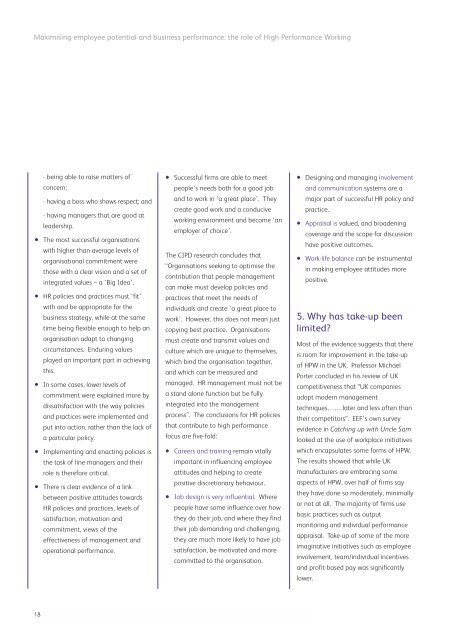About EEF - CIPD
About EEF - CIPD
About EEF - CIPD
You also want an ePaper? Increase the reach of your titles
YUMPU automatically turns print PDFs into web optimized ePapers that Google loves.
Maximising employee potential and business performance: the role of High Performance Working- being able to raise matters ofconcern;- having a boss who shows respect; and- having managers that are good atleadership.• The most successful organisationswith higher than average levels oforganisational commitment werethose with a clear vision and a set ofintegrated values – a ‘Big Idea’.• HR policies and practices must ‘fit’with and be appropriate for thebusiness strategy, while at the sametime being flexible enough to help anorganisation adapt to changingcircumstances. Enduring valuesplayed an important part in achievingthis.• In some cases, lower levels ofcommitment were explained more bydissatisfaction with the way policiesand practices were implemented andput into action, rather than the lack ofa particular policy.• Implementing and enacting policies isthe task of line managers and theirrole is therefore critical.• There is clear evidence of a linkbetween positive attitudes towardsHR policies and practices, levels ofsatisfaction, motivation andcommitment, views of theeffectiveness of management andoperational performance.• Successful firms are able to meetpeople’s needs both for a good joband to work in ‘a great place’. Theycreate good work and a conduciveworking environment and become ‘anemployer of choice’.The <strong>CIPD</strong> research concludes that“Organisations seeking to optimise thecontribution that people managementcan make must develop policies andpractices that meet the needs ofindividuals and create ‘a great place towork’. However, this does not mean justcopying best practice. Organisationsmust create and transmit values andculture which are unique to themselves,which bind the organisation together,and which can be measured andmanaged. HR management must not bea stand alone function but be fullyintegrated into the managementprocess”. The conclusions for HR policiesthat contribute to high performancefocus are five-fold:• Careers and training remain vitallyimportant in influencing employeeattitudes and helping to createpositive discretionary behaviour.• Job design is very influential. Wherepeople have some influence over howthey do their job, and where they findtheir job demanding and challenging,they are much more likely to have jobsatisfaction, be motivated and morecommitted to the organisation.• Designing and managing involvementand communication systems are amajor part of successful HR policy andpractice.• Appraisal is valued, and broadeningcoverage and the scope for discussionhave positive outcomes.• Work-life balance can be instrumentalin making employee attitudes morepositive.5. Why has take-up beenlimited?Most of the evidence suggests that thereis room for improvement in the take-upof HPW in the UK. Professor MichaelPorter concluded in his review of UKcompetitiveness that “UK companiesadopt modern managementtechniques…….later and less often thantheir competitors”. <strong>EEF</strong>’s own surveyevidence in Catching up with Uncle Samlooked at the use of workplace initiativeswhich encapsulates some forms of HPW.The results showed that while UKmanufacturers are embracing someaspects of HPW, over half of firms saythey have done so moderately, minimallyor not at all. The majority of firms usebasic practices such as outputmonitoring and individual performanceappraisal. Take-up of some of the moreimaginative initiatives such as employeeinvolvement, team/individual incentivesand profit-based pay was significantlylower.18
















